Featured Application
Our results showed that the structure of kinematic and kinetic core training is essential to improve CMJ performance and dynamic core flexion strength played a more critical role in improving CMJ with arm-swing. For all movements where arm-swing is used to increase jump height, athletes can benefit from enhanced dynamic core flexion strength. The specific characteristic of the core could be the key to understand how arm-swing helps improve jump height. In addition to the broad spectrum of core strength and stability training, coaches and athletes should pay special attention to the dynamic core flexion strength during training if using arm-swing to increase jump height is important.
Abstract
Background: Specificity of core strength training to sports events is crucial for performance improvement. The purpose of this study was to examine the specific relationship between core strength and countermovement jump (CMJ) performance. Methods: Twenty active college students (7 male, 13 female) participated in the project. CMJ heights with (HAS) and without arm-swing (HNAS) were estimated from vertical ground reaction force data collected using a force platform. Twelve dynamic and static core strength measurements of flexion and extension were tested using a dynamometer. The shared variance between CMJ height and core strength measurements was estimated using the square of Pearson correlation coefficients (R2). Linear regression analyses were conducted to determine which independent variables in core strength measurements were major predictors of CMJ height. Results: Significant correlations (p < 0.05) were observed between all 12 core strength measurements and CMJ height with/without arm-swing. Normalized (normalized with individuals’ body mass) peak torque during dynamic flexion at 180°per second (NPDF180) and normalized peak torque during static flexion at 120° (NPSF120) shared 72.0% variance with HAS, and NPSF120 shared 57.0% variance with HNAS. Conclusion: Dynamic core flexion strength is vital for using arm-swing to improve CMJ height. The structure of kinematic and kinetic core training could be considered to improve CMJ performance for coaches as well as professional and recreational athletes.
1. Introduction
The countermovement jump (CMJ) is a vital skill used frequently in many sports and recreational activities [1]. CMJ is usually combined with an arm-swing, which plays a crucial role in improving performance. Numerous previous studies have focused on the effect of arm-swing on the CMJ. It has been widely reported that jump height could be improved by 14–28% when using arm-swing [2,3,4]. Three theories, “transmission of force” [5], “pull” [3], and “joint torque augmentation” [1], have been proposed to explain the effect of the arm-swing on vertical jump height.
These theories can also be applied when discussing the role of the core in the transmission of force and energy during takeoff. Previous studies [6,7,8,9] have indicated that core strength is critical during energy transfer. Kibler et al. [7] defined core strength as: “the ability to control the position and motion of the trunk over the pelvis and leg to allow optimum production, transfer, and control of force and motion to the terminal segment.” Core strength also plays a vital role in force transmission between the upper and lower body [10,11,12]. It has been suggested that the core musculature is responsible for keeping the stability of the trunk and is crucial in transferring energy between the larger torso and smaller extremities in sport activities [8,9].
Therefore, core strength appears to play an essential role in energy and force transmissions, crucial in vertical jumps, especially with arm-swing. However, previous research has reported inconsistent conclusions on the relationship between core strength and vertical jump [13]. Some studies observed positive results [7,14,15,16] that core strength could enhance vertical jump performance, but others disagreed [17,18,19]. A variety of different core strength tests or training have been employed in previous studies. The “principle of dynamic correspondence” was applied to explain how training exercise improves performance and it was claimed that specific training modalities must be in harmony with those parameters of movement that characterize the structure of competition technique [20]. Only when core strength training is consistent with the kinetic and kinematic structures of the CMJ will the core strength effectively improve CMJ performance [12,20,21]. Thus, the confounding conclusions of core strength are mainly due to the neglect of the “specificity” of core strength to the sport event [6,8,12,22]. Although a recent study from authors [12] has disclosed the “specificity” of core stability by investigating the relationship between five core stability-related measurements and CMJ height, there is no study devoted to the relationship between different core strength types and exercise performance.
To detect the relationships between different types of core strength and CMJ performance, in order to help coaching and athlete development, we examined 12 core strength measurements, including dynamic strength at different speeds and static core strength at different positions. The study aimed to investigate whether the dynamic and static core strength measurements have different correlations with CMJ height with and without arm-swing. We hypothesized that CMJ heights, both with and without arm-swing, have significant but different relationships with all 12 core strength measurements.
2. Methods
2.1. Participants
Participants were recruited from a university using flyers and in-class announcements. All participants were right lower extremity dominant and free from lower back and lower extremity injuries or disease within the past two years. The university ethics review board approved the study. Participants signed the informed consent form after the testing protocol was thoroughly explained, and all questions answered satisfactorily.
2.2. Testing Procedure
Age, body mass, and height were recorded. Each participant was assigned an ID to protect the participants’ confidentiality. Before testing, each participant was asked to perform a 5-min warm-up following a “quick warm-up cardio workout” video. There were two testing sessions, with a 30 min rest in between, including a CMJ test and a core strength test for all the participants. The CMJ was tested first.
2.3. CMJ Test
The CMJ height was defined as the distance that the center of mass traveled between takeoff and maximum jump height. The participants stood on a force plate (AMTI Corporation, Watertown, MA, USA), sampling at 1000 Hz, and performed two types of CMJ: with and without arm-swing (arms fixed at their waists). The participants chose their squat depth and distance between their feet to maximize CMJ height. They stood on the platform quietly for 2–3 s, squatted down, and jumped quickly as high as they could. Every type of CMJ tested had three trials with sufficient time (at least 30 s, longer based on the participant request) in between to guarantee the participants’ maximal effort. The highest jump of each type was chosen to be analyzed. See Figure 1 for the set up for the CMJ jump data collection. A video camera was set up on the right side to capture the movement for verification purposes if needed.
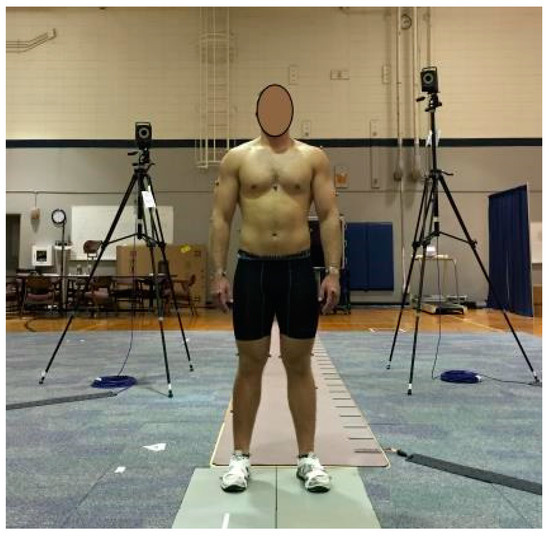
Figure 1.
Countermovement jump (CMJ) test environment.
2.4. Core Strength Test
Core strength was tested on a dynamometer (Biodex Medical Systems, Shirley, NY, USA). The participants were seated on the dynamometer with their arms crossed and hands on the opposite shoulders. Their trunks were the only body part able to move during the tests. The lumbosacral junction, 3.5 cm below the top of the iliac crest, was aligned with the axis of the dynamometer [23]. The knee joint was set at 120° of flexion throughout testing. The order of dynamic and static tests were randomized. The order of flexion and extension tests was randomized within the dynamic or static tests. Dynamic flexion and extension core strength were tested at three speeds, 60, 120, and 180°/s; static flexion and extension core strength were tested at three trunk flexion positions, 60, 90, and 120°. A seventy-degree range of motion (0–70° of trunk flexion) was set for trunk movement during the dynamic testing. Each test was repeated five times with at least one-minute rest in between tests. Participants were instructed to flex and extend the trunk with maximum efforts, but stop if they felt uncomfortable in the process. Participants practiced the protocol with a submaximal intensity before the test. The intra-rater reliability of the trunk flexion and extension test was 0.62 and 0.81 [24]. See Figure 2 for the dynamometer setup.
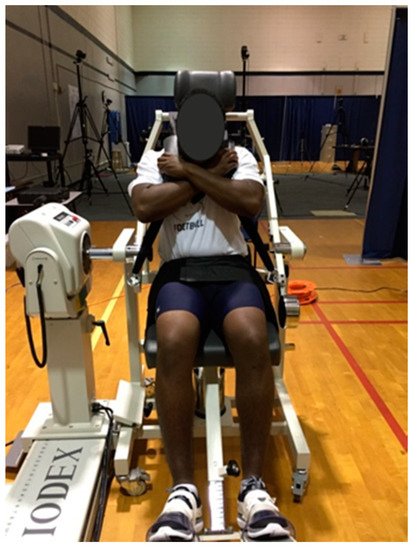
Figure 2.
Core strength test setup on a dynamometer.
2.5. Data Calculation
Ground reaction force data were filtered using a 44 Hz low-pass, zero-lag Butterworth filter.
The CMJ height was estimated as follows:
Since,
(1/2) mVT2 = mgh (Mechanical Energy Conservation)
Therefore,
where m = body mass, VT = takeoff velocity, g = gravitational acceleration, and h = center of mass height changes from takeoff to the maximum CMJ height. (Note: we do not know the difference between the center of mass vertical positions between quiet standing and takeoff by using this method.)
h = VT2/(2g)
Vertical ground reaction force was measured with a 2–3 s (Figure 3) quiet standing period before takeoff. We chose 2 s before takeoff as time zero. Based on the impulse–momentum relationship:
where T0 = takeoff time, m = body mass, and Fv = vertical ground reaction force.
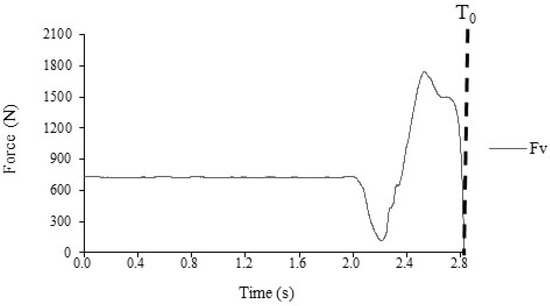
Figure 3.
Exemplar vertical force–time profile during quiet standing and takeoff of CMJ without arm-swing.
So, CMJ height can be expressed as follows:
2.6. Data Analysis
Statistical analysis was performed with SPSS for Windows (SPSS version 23.0, IBM Corporation, Armsonk, NY, USA). The shared variance between CMJ height and any of the 12 core strength measurements was estimated using the square of Pearson correlation coefficients (R2). Normality was checked using the Kolmogorov–Smirnov test. A log-transformation would be used if the normality were not met and would be rechecked after the transformation. CMJ height with and without arm-swing, and differences between flexion and extension core strength measurements, was examined with paired t-tests. A stepwise multiple linear regression was conducted to determine which independent variables in the 12 core strength measurements were the major predictors of CMJ height. CMJ heights with and without arm-swing were entered as dependent variables, and core strength measurements were entered as independent variables. The significance level was set at p ≤ 0.05 for all tests.
3. Results
Twenty active college students, 7 males and 13 females (age: 22.1 ± 0.2 years old, body mass: 75.8 ± 3.5 kg, height: 1.72 ± 0.02 m), were recruited for the study. Countermovement jump (CMJ) heights with and without arm-swing were 38.2 ± 2.0 and 31.9 ± 1.8 cm, respectively.
Table 1 presents the descriptive results of the mean ± standard error of the mean (SE) for 12 core strength measurements and CMJ height.

Table 1.
Descriptive statistics for core strength measurements (n = 20).
Normality was confirmed before the regression analysis. Table 2 shows the shared variance (R2) between CMJ height and 12 core strength measurements. All dynamic core strength at three speeds and static core strength at three positions have shared significant variance with CMJ height with/without arm-swing.

Table 2.
Shared variance (R2) between CMJ height and core strength measurements (n = 20).
Figure 4 shows the results of the linear regressions of CMJ height with arm-swing (HAS) and 12 core strength measurements. The regression model demonstrated that variation in peak torque during dynamic flexion at 180° per second (NPDF180) and variation in normalized peak torque during static flexion at 120° (NPSF120) explained 72% of variation in performance in CMJ with arm swing. The possibility of colinearlarity was low since the variance inflation factor for both independent variables was at 1.140.
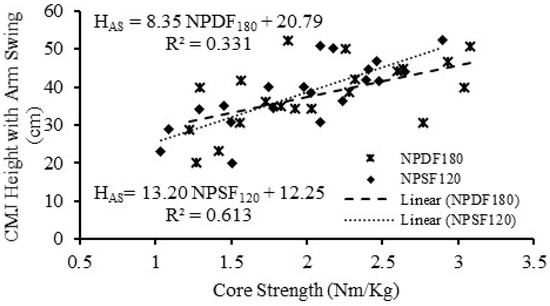
Figure 4.
Results of linear regression analyses of CMJ height with arm-swing (HAS) with 12 core strength measurements (n = 20), which were tested on a dynamometer and included normalized (with body mass) peak torque during dynamic extension/flexion at 60, 120, and 180° per second and normalized peak torque during static extension/flexion at 60, 90, and 120°.
Figure 5 shows the results of the linear regression analyses of CMJ height without arm-swing (HNAS) and 12 core strength measurements. Normalized peak torque during static flexion at 120° (NPSF120) was the only variable left in the regression analysis, and it explained 57% of the variance observed in HNAS (p < 0.01, VIF = 1.000).
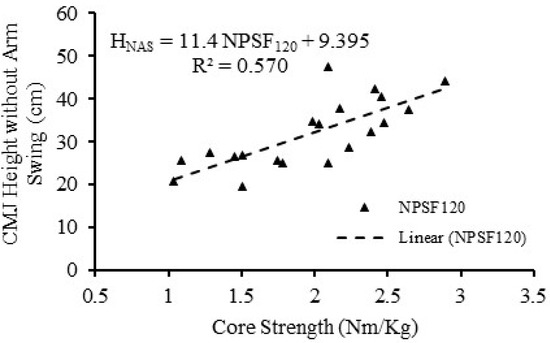
Figure 5.
Results of regression analysis of CMJ height without arm-swing (HNAS) with 12 core strength measurements (n = 20) are the same as in Figure 4.
4. Discussion
We studied the relationships between a variety of measures of core strength tests and countermovement jump (CMJ) heights with/without arm-swing. Significant correlations were detected between all 12 core strength measurements and CMJ heights with/without arm-swing. The results of the linear regression analyses showed that NPDF180 and NPSF120 shared 72% variance with CMJ height with arm-swing (HAS), where NPSF120 shared 57.0% variance with CMJ height without arm-swing (HNAS). Therefore, NPDF180 and NPSF120 combined were good predictors for HAS, and NPSF120 alone was a good predictor for HNAS.
Although some differences exist in how previous research explains the impact of arm-swing on vertical jump, it stresses the importance of core strength during takeoff [1,3,5]. Individuals with a stronger core could benefit more from arm-swing during the jump’s takeoff, compared to people with a weaker core [6,8,9]. In the present study, significant correlations between CMJ height with arm-swing and all 12 core strength measurements were detected and supported the hypothesis. Moreover, the 12 core strength measurements were also significantly correlated with CMJ height without arm-swing. Dynamic and static core strength play different roles in exercise performance. Static core strength, especially core flexion strength, can keep the body stable and provide a good foundation for CMJ performance. Again, dynamic core strength, especially the core flexion strength, can facilitate force and power transfer to improve CMJ performance [6,8]. Coaches and professional and recreational athletes could try and see if improving both dynamic core strength and static core strength could improve CMJ height.
The relationship between core strength and performance reported in previous studies was inconsistent. Some studies have observed positive results [14,15,16], but others disagreed [17,18,22,25]. Sharma et al. [15] found that spike jump and block jump improved significantly after nine weeks of core strength training. Prieske et al. [14] observed sprint and kicking performance improvement after core strength training on stable and unstable surfaces. Prieske et al. [26] found that dynamic core extensor strength correlated with drop jump height without arm-swing significantly but showed only a weak correlation between dynamic core flexor strength and drop jump height. The standing position was chosen to test the Prieske study’s participant’s core strength, but we tested the core strength with a sitting position in the present study. The sitting position could decrease the core extension strength but is an excellent position to evaluate the maximum core flexion strength. That may be the reason for strong correlation between CMJ height and core flexion strength in the present study. However, the kinetic and kinematic structures of the core strength test in sitting position were inconsistent with the CMJ in upright positon, in which the feet need to load the body weight. That may affect the degree of correlation between core extension strength with CMJ performance in the present study. We have attempted to approximate the sporting movement in the strength test. The sitting position used in our study and the subsequent range of movement, approximates the position the participants would be at when they start to generate forces in the jump and the range of movement. Schilling et al. [17] investigated the effect of core strength and endurance training on performance. They reported that neither training protocol showed superiority, and both were ineffective in improving sprint, vertical jump, and agility performance. They suggested that the large sample size and core musculature power training should be considered for future projects. A recent study from Guo et al. [12] investigated the relationship between five core stability-related measurements and CMJ height. They reported that trunk extensor endurance, one-minute sit-up, and dominant leg standing time had no significant correlation with CMJ height, with or without arm-swing. Trunk flexion and extension range of motion and dominant leg hop distance had a significant correlation with CMJ height both with and without arm-swing. They concluded that “specificity” should be considered for core training to improve CMJ performance.
Despite the inconsistent results, many elite athletes continue to perform core strength training as an essential part of their training program. The “principle of dynamic correspondence” should be considered to understand this confounding situation [20]. This principle states that special exercises must be in harmony with those parameters of movement that characterize the structure of competition technique. Thus, only when core strength training is consistent with the CMJ in kinetic and kinematic structures can strength training effectively improve CMJ performance [20,21]. Therefore, the confounded conclusions of core strength are mainly due to the neglect of the “specificity” of core strength to the sporting event [6]. Different core exercises train the different core musculature in various forms, while performance mainly depends on the “specificity” of the core strength. Specific and targeted core strength training should be considered relevant research projects and training protocols [6,22,25]. Normalized peak torque during both dynamic flexion at 180° per second (NPDF180) and static flexion at 120° (NPSF120) shared 72.0% variance with CMJ height with arm-swing (HAS), while NPSF120 shared 57.0% variance with CMJ height without arm-swing (HNAS). Buffering and extension periods are included in the whole CMJ motion. The core is dominant and plays a major role in the buffering period but the dominant region moves to the lower limbs in the extension period, in which the lower limbs need to afford more load than body weight. Especially in the end of the extension period, the ankle contributes most of the push power. In the present study, trunk (lumbar-pelvic) muscle, not hip, contributed most of the power in the trunk strength test. Thus, trunk flexion strength plays an important role in the buffering period of the CMJ, but trunk extension strength in the extension period is not as important as trunk flexion strength in the buffering period. That could explain why all predictors of CMJ height with and without arm-swing were trunk flexion strength (NPDF180 and NPSF120) in the present study.
Regarding the kinematic and kinetic structures of the core strength tests, NPDF180 was the fastest test in the dynamic core strength tests, in which core muscle contractions were fastest. It is necessary for the CMJ to yield maximum trunk flexion power, increasing the coming trunk extension power to promote CMJ performance. The NPSF120 test had the most similar posture (with the hip angle of about 120°) to the CMJ in the buffering period, which we observed in the video we captured. Thus, the kinematic and kinetic structures of the core test were vital to evaluate the correlation between core strength and CMJ performance [20]. Moreover, one static core strength could be used to explain the majority variance of CMJ height without arm-swing, but both static and dynamic core strength was needed to explain the variation of CMJ height with arm-swing. Thus, both static and dynamic core strength should be considered to study CMJ with arm-swing, but the dynamic core strength in CMJ without arm-swing is not as important as in CMJ with arm-swing. There is an active flexion period at the beginning of the CMJ. The dynamic core flexion strength plays an important role in the flexion period and makes the flexion more powerful. A faster and deeper active flexion period would lead to a more powerful backswing of the arm. The powerful backswing of the arm leads to a more effective forward swing and better CMJ performance.
Consequently, researchers should pay more attention to dynamic core flexion strength when studying core strength’s effect on improving CMJ with arm-swing.
5. Limitations
The present study results indicated that both dynamic trunk strength tests at different speeds and static core strength at different positions were strongly related to CMJ height with/without arm-swing, but we did not use an intervention experiment to confirm this result. Targeted training of static and dynamic core strength could be conducted in future studies. We recruited university students in the present study, but athletes with stronger core capacity and better sports performance should be tested in the future. There may be sex differences in the relationships we have observed here. Future projects could be designed to explore the differences between male and female athletes for more sex-specific training suggestions.
6. Conclusions
Both dynamic core strength at different speeds and static core strength at different positions were strongly related to CMJ height with/without arm-swing. However, dynamic core flexion strength played a more critical role in improving CMJ performance with arm-swing than in the performance of CMJ without arm-swing. The structure of kinematic and kinetic core training could be considered to see if it can improve CMJ performance for coaches and professional and recreational athletes.
Author Contributions
Conceptualization, L.G., L.L. and Y.W.; methodology, L.G. and L.L.; software, L.G.; validation, L.G., L.L. and Y.W.; formal analysis, L.G. and L.L.; investigation, L.G.; resources, L.L.; data curation, L.G.; writing—original draft preparation, L.G.; writing—review and editing, L.L.; visualization, L.L.; supervision, L.L. and Y.W.; project administration, L.G. and L.L.; funding acquisition, L.G. All authors have read and agreed to the published version of the manuscript.
Funding
This research was funded by the China Postdoctoral Science Foundation, grant number 2020M672663.
Acknowledgments
The authors wish to express their gratitude to Klarie Ake and Eva Blaise for their assistance in data collection.
Conflicts of Interest
The authors declare no conflict of interest. The funders had no role in the design of the study; in the collection, analyses, or interpretation of data; in the writing of the manuscript; or in the decision to publish the results.
References
- Feltner, M.E.; Fraschetti, D.J.; Crisp, R.J. Upper extremity augmentation of lower extremity kinetics during countermovement vertical jumps. J. Sports Sci. 1999, 17, 449–466. [Google Scholar] [CrossRef]
- Lees, A.; Vanrenterghem, J.; De Clercq, D. The energetics and benefit of an arm swing in submaximal and maximal vertical jump performance. J. Sports Sci. 2006, 24, 51–57. [Google Scholar] [CrossRef]
- Harman, E.A.; Rosenstein, M.T.; Frykman, P.N.; Rosenstein, R.M. The effects of arms and countermovement on vertical jumping. Med. Sci. Sports Exerc. 1990, 22, 825–833. [Google Scholar] [CrossRef] [PubMed]
- Giatsis, G.; Panoutsakopoulos, V.; Kollias, I.A. Biomechanical differences of arm swing countermovement jumps on sand and rigid surface performed by elite beach volleyball players. J. Sports Sci. 2018, 36, 997–1008. [Google Scholar] [CrossRef] [PubMed]
- Payne, A.H.; Slater, W.J.; Telford, T. The Use of a Force Platform in the Study of Athletic Activities. A Preliminary Investigation. Ergonomics 1968, 11, 123–143. [Google Scholar] [CrossRef] [PubMed]
- Hibbs, A.E.; Thompson, K.G.; French, D.N.; Wrigley, A.; Spears, I.R. Optimizing Performance by Improving Core Stability and Strength. Sports Med. 2008, 38, 995–1008. [Google Scholar] [CrossRef] [PubMed]
- Kibler, W.B.; Press, J.; Sciascia, A. The Role of Core Stability in Athletic Function. Sports Med. 2006, 36, 189–198. [Google Scholar] [CrossRef] [PubMed]
- Guo, L.; Li, L.; Wu, Y. Review on the hot issues of core stability research. J. Shanghai Univ. Sport 2019, 35, 113–118. [Google Scholar] [CrossRef]
- Li, L.; Waldhelm, A. Historical and Current Understanding of Core Stability. Sport Sci. Res. 2011, 32, 1–9. [Google Scholar]
- Stephenson, J.; Swank, A.M. Core Training: Designing a Program for Anyone. Strength Cond. J. 2004, 26, 34–37. [Google Scholar] [CrossRef]
- Guo, L.; Li, L.; Wu, Y. Research on Predicting Trunk Isometric Strength with Core Stability Related Measurements. J. Shanghai Univ. Sport 2018, 42, 93–98. [Google Scholar] [CrossRef]
- Guo, L.; Li, L.; Wu, Y. The relationship between Core Stability Related Measurements and Countermovement Jump Height with/without Arm Swing. China Sports Sci. 2018, 38, 67–72. [Google Scholar] [CrossRef]
- Clark, D.R.; Lambert, M.I.; Hunter, A.M. Contemporary perspectives of core stability training for dynamic athletic performance: A survey of athletes, coaches, sports science and sports medicine practitioners. Sports Med. Open 2018, 4, 32. [Google Scholar] [CrossRef] [PubMed]
- Prieske, O.; Muehlbauer, T.; Borde, R.; Gube, M.; Bruhn, S.; Behm, D.G.; Granacher, U. Neuromuscular and athletic performance following core strength training in elite youth soccer: Role of instability. Scand. J. Med. Sci. Sports 2016, 26, 48–56. [Google Scholar] [CrossRef] [PubMed]
- Sharma, A.; Geovinson, S.G.; Singh, J.S. Effects of a nine-week core strengthening exercise program on vertical jump performances and static balance in volleyball players with trunk instability. J. Sports Med. Phys. Fit. 2012, 52, 606–615. [Google Scholar]
- Yaggie, J.A.; Campbell, B.M. Effects of Balance Training on Selected Skills. J. Strength Cond. Res. 2006, 20, 422. [Google Scholar] [CrossRef]
- Schilling, J.F.; Murphy, J.C.; Bonney, J.R.; Thich, J.L. Effect of core strength and endurance training on performance in college students: Randomized pilot study. J. Bodyw. Mov. Ther. 2013, 17, 278–290. [Google Scholar] [CrossRef]
- Tse, M.A.; McManus, A.M.; Masters, R.S. Development and Validation of a Core Endurance Intervention Program: Implications for Performance in College-Age Rowers. J. Strength Cond. Res. 2005, 19, 547. [Google Scholar] [CrossRef]
- Lago-Fuentes, C.; Rey, E.; Padrón-Cabo, A.; De Rellán-Guerra, A.S.; Fragueiro-Rodríguez, A.; García-Núñez, J. Effects of Core Strength Training Using Stable and Unstable Surfaces on Physical Fitness and Functional Performance in Professional Female Futsal Players. J. Hum. Kinet. 2018, 65, 213–224. [Google Scholar] [CrossRef]
- Müller, E.; Benko, U.; Raschner, C.; Schwameder, H. Specific fitness training and testing in competitive sports. Med. Sci. Sports Exerc. 2000, 32, 216. [Google Scholar] [CrossRef]
- Baker, D. Improving Vertical Jump Performance Through General, Special, and Specific Strength Training. J. Strength Cond. Res. 1996, 10, 131–136. [Google Scholar] [CrossRef]
- Nesser, T.W.; Huxel, K.C.; Tincher, J.L.; Okada, T. The Relationship Between Core Stability and Performance in Division I Football Players. J. Strength Cond. Res. 2008, 22, 1750–1754. [Google Scholar] [CrossRef]
- Karataş, M.; Çetin, N.; Bayramoğlu, M.; Dilek, A. Trunk Muscle Strength in Relation to Balance and Functional Disability in Unihemispheric Stroke Patients. Am. J. Phys. Med. Rehabil. 2004, 83, 81–87. [Google Scholar] [CrossRef]
- Waldhelm, A.; Li, L. Endurance tests are the most reliable core stability related measurements. J. Sport Health Sci. 2012, 1, 121–128. [Google Scholar] [CrossRef]
- Stanton, R.; Reaburn, P.R.; Humphries, B. The Effect of Short Term Swissball Training on Core Stability and Running Economy. J. Strength Cond. Res. 2004, 18, 522–528. [Google Scholar] [CrossRef]
- Prieske, O.; Muehlbauer, T.; Krueger, T.; Kibele, A.; Behm, D.G.; Granacher, U. Role of the trunk during drop jumps on stable and unstable surfaces. Eur. J. Appl. Physiol. 2014, 115, 139–146. [Google Scholar] [CrossRef] [PubMed]
Publisher’s Note: MDPI stays neutral with regard to jurisdictional claims in published maps and institutional affiliations. |
© 2020 by the authors. Licensee MDPI, Basel, Switzerland. This article is an open access article distributed under the terms and conditions of the Creative Commons Attribution (CC BY) license (http://creativecommons.org/licenses/by/4.0/).